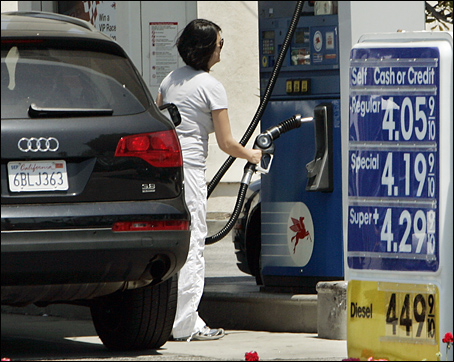
Sam Sherraden is a Program Associate with the New America Foundation’s Economic Growth Program and writes for Global Economic Snapshot.
As my cab approached Dulles Airport last week from my Washington home 45 minutes away, I looked up and was astonished to see the meter at only 45 dollars. After the driver paid for gas on a 60 mile ride (the 30 mile drive to the airport and 30 mile drive back to the district where he could get another fare), costs of vehicle maintenance, and one and half hours of time, I couldn’t believe he turned much of a profit. I leaned forward and asked him a question to that effect. “It’s not just gas, man!” he replied. “Milk and all those things I feed my kids. They are ALL more expensive.”
Oil prices peaked last weak at just under $140 a barrel and gas prices nationwide have risen above $4 per barrel. Middle income Americans and small business are struggling to find ways around higher food and energy prices. The Wall Street Journal offered some dismal advice last week on how small business can survive with higher prices by rerouting deliveries to save fuel, using energy efficient light bulbs, and holding meetings online instead of paying for airfare. But when compared the rising cost of inputs for business and families, these savings are limited in scope and impact. The cab driver and many other folks I’ve spoken with are not feeling any relief.
Nor does it appear relief is on the horizon. High prices of energy and food coincide with a deflating housing bubble and sinking consumer confidence. Much of the optimism about the economy has been torn apart and replaced by anxiety. The stimulus checks appear to have provided a bump to consumption, but it is unclear that once that shot in the arm wears off the economy will be on a path to recovery. Trouble in financial markets is spilling into the real economy with more financial institutions on loose footing and access to credit continually difficult. The Fed has aggressively cut interest rates, but this erodes the dollar, causes inflation, and forces international investors to look toward the euro. Put simply, the outlook for the remainder of 2008 looks grim.
To discuss these issues and a set of policy solutions to reorient the economy during the next administration, we booked two events at the New America Foundation this week.
On Wednesday, June 25 Leo Hindery, former Senior Economic Advisor to John Edwards and current unofficial advisor to Barack Obama, and Tom Gallagher, Senior Managing Director of International Strategy and Investment Group, Inc., will speak about structural changes we need to strengthen the economy.
On Friday, June 27 Los Angeles Times National Economics Correspondent Peter Gosselin will speak about his new book, High Wire: The Precarious Financial Lives of American Families.
— Sam Sherraden


36 comments on “<em>Guest Post</em>: The Squeeze in Middle America”